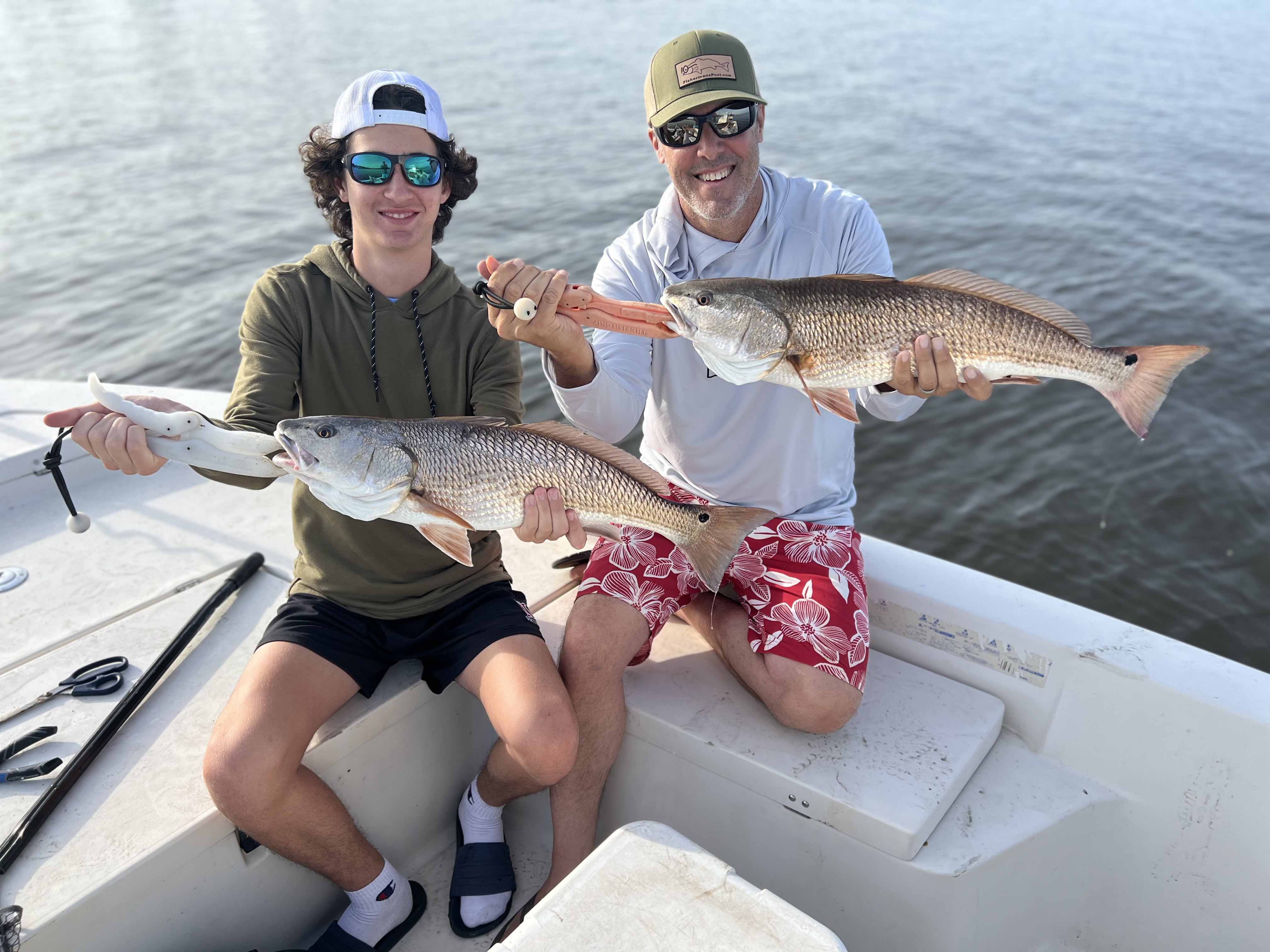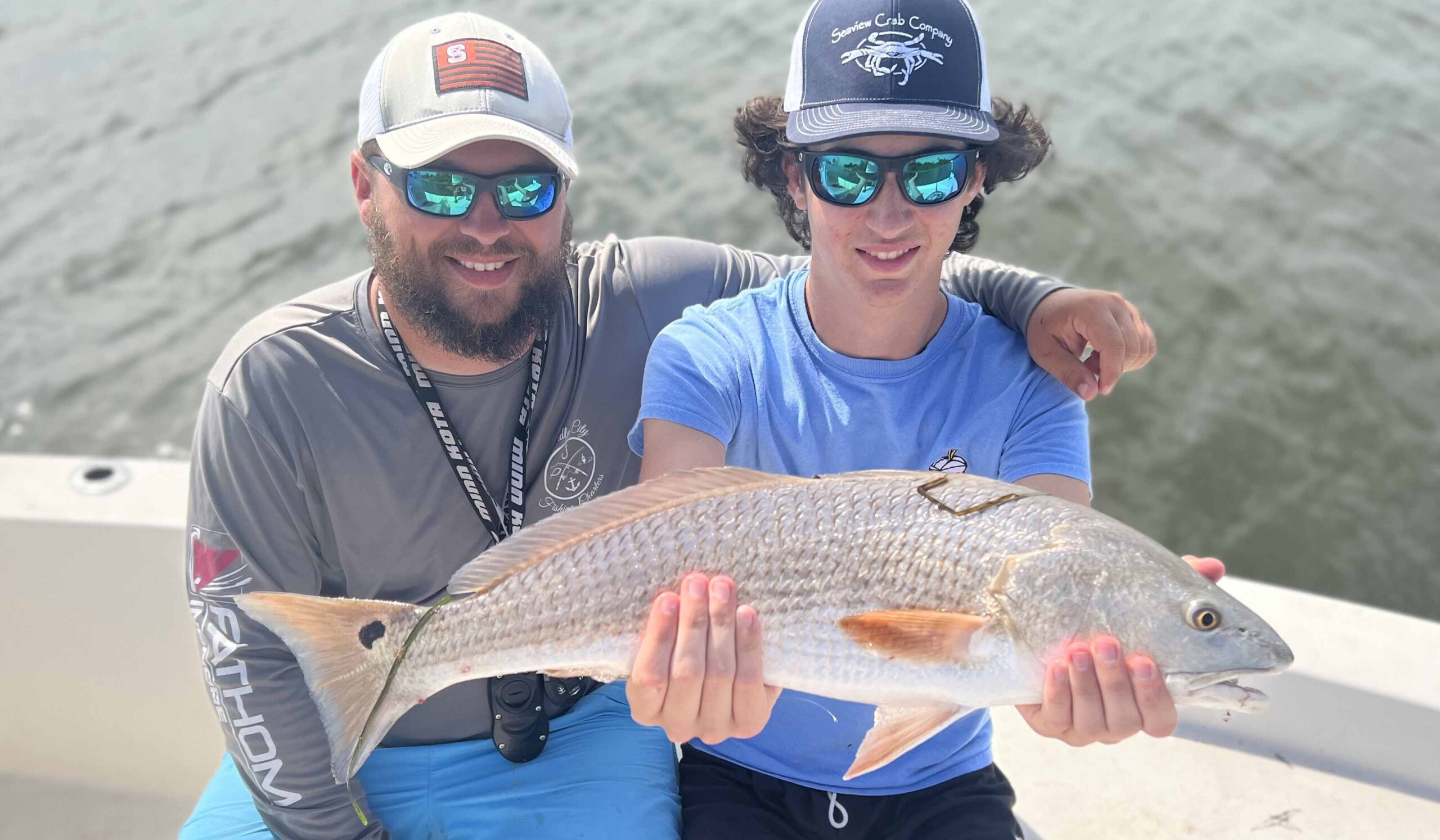Tidelines – June 2022
In our new weekly inshore fishing reports and forecasts, I’ve been hearing Capt. Matt Littleton, of Friendly City Fishing Charters, talk each week about red drum in the Swansboro area. In another world where I have more free time, I might have towed my boat up to Swansboro to try and follow his advice myself, but I’m not in another world.
I’m still in the world where I had a small window to fit in a fishing trip on the Monday morning before this issue went to print, so instead of following Matt’s advice on my own, my son James and I decided to follow Matt’s advice on Matt’s boat.
Casper’s Marina, located on the Swansboro waterfront, is where Matt conveniently meets his clients, as in convenient for his clients like me and convenient for Matt, too, as on our day it was a relatively short run from their docks to our first stop of the morning.

Early summer (or late spring, however you view late May) mostly means looking for red drum in the Swansboro area in the marshes or up the rivers
“If we were fishing out in the marsh,” Matt explained, “we would primarily be looking for areas you know were holding fish in the winter because those schooling fish stay together and then break up into smaller pods. Those pods gradually break down until the fish are spread out like you get with summer fishing.”
“We’re fishing a different body of water,” he continued. “We’re in the White Oak River today, and in the White Oak you get, I don’t want to say a different population, but these fish act a different way. These fish will hold to structure. They’ll hold to the same bottom and kinda be all over the place, and you just have to know where exactly they are on a given day.”
Apparently, Matt had found a nice pod of fish on the Saturday before our trip, and then left them alone on Sunday so they would (hopefully) be ready to cooperate on our Monday morning. We trolling-motored up to a dock, and Matt described the dock as having flats on either side and the flats and dock all dropped off into some deeper water.
He opened up a pack of a dozen vacuum-sealed finger mullet from Cape Point Bait Co., cut each mullet in half, put the halves in a small bucket, and put the small bucket on the leaning post.
James asked about how to hook the bait on our Carolina rigs, and Matt replied, “Where the gill plate separates on the bottom of their head, you go right between both of those, and then spin that circle hook and ‘pop’ it right out of the top of his head. When you hear that barb ‘click’ through, you know you have a good hook.”
We were using Carolina rigs, but Matt likes to tie them a little differently.
“I tie a modified Carolina rig, which you’ve seen on the Fisherman’s Post podcast I did,” he continued. “This rig you only give the fish about six inches to swim with the bait before it’s going to catch and pull. With a traditional Carolina rig where you put the weight above a swivel, depending on which direction he swims, he could slide for a while before he ever gets pulled back on.”
Matt cast the first two rods to sit just off of each side of the dock, and then directed James and me to spread our two casts out on the flat to the right of the dock to cover more water until we found the fish. Before either James or I could cast, though, one of Matt’s rods bent down in the rod holder.
James was quick to the rod but suddenly had a confused look. In the thrill and excitement of a nice red drum pulling drag, he managed to say that something didn’t feel right.
Matt was first to diagnose. The reel in James’ hand was set up for a left hander. Matt is left-handed, and the clients he had on the boat the day before were left-handed, so James found himself with the rod in his left hand while clumsily trying to reel with his right.
Fortunately, Matt told us, fish in this area don’t immediately run to the dock pilings. They first head out and away from the dock to the deeper water, so James had time to acclimate.
Matt reminded James at times to keep his rod tip up high, and then he had James move to the front deck of the boat to get even more height, explaining that more height meant more and better pressure on the fish.
As the fish got close, it made a quick move under the boat, and Matt was just as quick to direct James to drop his rod tip low, even putting it in the water, and then pulling up and back out and away from the boat.
Soon the fish was ready, so Matt’s final instruction to James was to reel down and pull up to guide the fish into the waiting landing net.
James’ 25-inch fish went into the livewell, and we went back to the same system: fan casting out cut mullet, waiting for a rod to bend, and then fighting upper-slot fish to the boat.

James Hurley with an upper-slot redfish that hit a piece of cut mullet in about 3′ of water off of some structure. He was fishing with Capt. Matt Littleton (left), of Friendly City Fishing Charters.
Capt. Matt Littleton, of Friendly City Fishing Charters out of the Swansboro area, loves to put his clients on solid red drum action throughout the summer and fall, and he also likes to teach and share knowledge with his clients. James is certainly a better angler after spending a half day with Matt.
In addition to being guide for the last eight years, Matt is also a relatively new father, as his son is nearing his second birthday. James (the middle of three boys) and I thought we would reciprocate a little and teach and share knowledge with Matt on what he might expect as his son grows older.
James and I predicted that Matt’s future raising a boy would involve plenty of childish penis references. For example, you, too, might have thought to yourself that the siren of an ambulance makes a noise that sounds like “wiener, wiener, wiener,” but did you know that you hear the word “penis” every time you say the word happiness?
